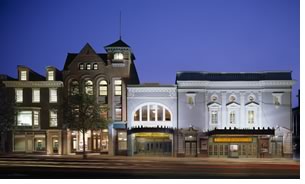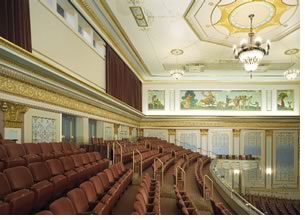

07/2004
An Encore Performance for Westlake Reed Leskosky’s York Theatre Project
 The
re-openings of the 1925 Strand Theatre and the 1906 Capitol Theatre in
York, Pa., mark a new lease on life for two treasures that have been on
the National Register of Historic Places since 1979. The $17.3 million
project, led by Westlake Reed Leskosky (formerly van Dijk Westlake Reed
Leskosky), encompasses restoration, adaptive reuse, and new construction,
joining together four landmark buildings of various styles, vintages,
floor levels, and construction types, and three new building additions
to create a unified venue for the Strand-Capitol Performing Arts Center.
The
re-openings of the 1925 Strand Theatre and the 1906 Capitol Theatre in
York, Pa., mark a new lease on life for two treasures that have been on
the National Register of Historic Places since 1979. The $17.3 million
project, led by Westlake Reed Leskosky (formerly van Dijk Westlake Reed
Leskosky), encompasses restoration, adaptive reuse, and new construction,
joining together four landmark buildings of various styles, vintages,
floor levels, and construction types, and three new building additions
to create a unified venue for the Strand-Capitol Performing Arts Center.
The Capitol Theatre is integrated into the center with support space share with the Strand, stage expansion, and backstage improvements. The Strand Theatre boasts new 250-seat mezzanine balcony seating, enhanced backstage facilities, a new 49-line set stage house, renovated lobby space expanded to double its size, additional support space, and restoration of the exterior façade and interior decorative ornamentation. The new design also added new rehearsal hall and community multipurpose meeting spaces. From Broadway touring shows, visiting artists, and programming of the York Symphony Orchestra to educational offerings such as dance workshops, artist discussions, and master classes, all the performing arts have a place to thrive in the new facility.
 The
purchase of property adjacent to the theaters allowed for the construction
of a new two-story structure to serve the backstage needs of both with
one stage entry. The Capitol received the support space and the Strand’s
stage and stage house have been enlarged and truck load-in improved to
enable it to serve outside presenters and touring shows more fully. New
patron amenities and significant new rehearsal space in the upper volume
of the new addition serve the entire complex.
The
purchase of property adjacent to the theaters allowed for the construction
of a new two-story structure to serve the backstage needs of both with
one stage entry. The Capitol received the support space and the Strand’s
stage and stage house have been enlarged and truck load-in improved to
enable it to serve outside presenters and touring shows more fully. New
patron amenities and significant new rehearsal space in the upper volume
of the new addition serve the entire complex.
The proscenium of the Capitol, covered for more than three decades, is now exposed and restored, and the balcony has been renovated to improve comfort and sight lines. Designers enlarged the Capitol’s stage. Renovation of the Strand focused on the exterior façade and the complete revitalization of the theater’s interior.
 “The
Strand has come alive with the restoration of the delicate beauty of its
fine details, rich palette, artwork, and ornament, all seen in harmony
and with fresh light,” says principal architect Paul E. Westlake
Jr., FAIA. He notes the new addition presented an opportunity to shape
the urban landscape. “Visually and functionally, the Strand-Capitol
Performing Arts Center is now integrated on the exterior and the interior,
and the city block unified and transformed to give a strong downtown presence.”
“The
Strand has come alive with the restoration of the delicate beauty of its
fine details, rich palette, artwork, and ornament, all seen in harmony
and with fresh light,” says principal architect Paul E. Westlake
Jr., FAIA. He notes the new addition presented an opportunity to shape
the urban landscape. “Visually and functionally, the Strand-Capitol
Performing Arts Center is now integrated on the exterior and the interior,
and the city block unified and transformed to give a strong downtown presence.”
Saving two theaters with one plan
Costing more than $1 million, the Strand Theatre exemplified Italian Renaissance
architecture with its marble terrazzo floor, graceful archways, and ornate
decorative details, including 1,800 pounds of gold leaf, 100 pounds of
bronze, 4,000 pounds of ribbon gold in pilaster moldings, a 2,800-pound
chandelier, and Spanish leather seats. It prospered during the Roaring
’20s and silent films, managed through the Great Depression, and
continued to show movies until the growth of residential suburbs and shopping
centers. With the decline of downtown businesses the two theaters suffered,
and the Strand closed in 1976. Later, involvement by dedicated community,
business, and public officials and Center’s board of directors saved
it from the wrecking ball. Intense fundraising efforts helped raise enough
capital to meet the expanded scope set by the Center’s board.
 A
key feature of the work in the Strand is the addition of a 250-seat mezzanine
balcony that enhances the visitor experience and compensates for seats
that were removed at the orchestra level for ADA-related upgrades. Elegant
function rooms overlooking the street were added at the mezzanine level,
providing amenities for patrons and a new revenue stream for the facility.
The renovation also provided entirely new mechanical and electrical infrastructure
and upgrades to life-safety, audio, and theatrical systems.
A
key feature of the work in the Strand is the addition of a 250-seat mezzanine
balcony that enhances the visitor experience and compensates for seats
that were removed at the orchestra level for ADA-related upgrades. Elegant
function rooms overlooking the street were added at the mezzanine level,
providing amenities for patrons and a new revenue stream for the facility.
The renovation also provided entirely new mechanical and electrical infrastructure
and upgrades to life-safety, audio, and theatrical systems.
Westlake describes the visual impact of the restoration efforts: “The Strand’s decoration is unique among its genre and its signature owes much to the murals by Pogany in the historic audience chamber. These murals are intimately related to the architectural decoration of the theatre, an example of the conspiracy of artists and artisans of the golden era of American theatre design who developed spaces of fantasy and illusion and escapism. The restoration of the murals celebrates them in the space, not only as fine artwork, but as a vital part of the success and visual richness of the Strand.”
Pogany is a Hungarian artist who created scenic designs for the Metropolitan Opera and the lavish Ziegfield Theatre. Collaborating with ornamental restorers EverGreene Painting Studios and Hayles & Howe Inc., the architect team restored and registered murals and rejuvenated the interiors with fine details and a polychrome palette set against the cream backgrounds that are harmonious to the original.
Along with Westlake Reed Leskosky, which provided architectural, mechanical, and electrical design services, Theatre Projects Consultants, with Webb Management Services, performed the market study. Separate personnel from Theatre Projects assisted in programming, and Jaffe Holden Acoustics participated as acoustic consultants. Kinsley Construction provided services in structural design and cost estimating.
Copyright 2004 The American Institute of Architects.
All rights reserved. Home Page ![]()
![]()
 |
||
| Images © Nels Akerlund Photography. This project is one of the pre-conference tours set for the annual meeting of the League of Historic American Theatres, July 21–24 in Philadelphia. At the conference, LHAT will welcome Kennedy Lawson Smith, its new executive director. She comes to the group from the National Trust for Historic Preservation’s National Main Street Center, which she has served as director since 1991. She will focus her efforts on a full-range of services and resources for operating historic theaters, redevelopment initiatives, and equity investments in historic theaters; and increased visibility for the role historic theaters play in the cultural and economic vitality of our communities.
|
||